Due to its location, Iaşi was at the crossroads of the main trade routes coming from Poland, Hungary, Russia and Constantinople. The first written evidence of the economic importance of Iaşi and also of its very existence comes from a 1408 charter by which the Moldavian ruler Alexandru cel Bun (Alexander the Good) granted commercial priority to the Polish merchants of Lvov.
Vasile Alecsandri National Theatre
It was built between 1894-
 1896, by the well-known Viennese architects, Fellner and Helmer.
1896, by the well-known Viennese architects, Fellner and Helmer. In 1956, when celebrating 140 years since the first performance in Romanian language, the theatre in Iasi received the name of the great poet, playwright and man of culture, Vasile Alecsandri (1821-1890).
Today, this architectural jewel houses also the Romanian National Iasi Opera.
1.jpg)
The master of the palace had 3 wives. The last of them, Maria, was the one that opened the gates of the palace for musicians and literates.
Here George Enescu and Haricleea Darcle had concerts, also here Mihai Eminescu lectured his poems. The dance parties offered by lady Marghiolita were famous in the whole region.
In 1891, Vasile Pogor buys the palace from the Roznovanu family and establishes the headquarters of the City Hall.
During 1893-1894, the building undergoes several changes (an additional storey is built and the chapel is demolished) and it becomes for a short time the residence of the royal family (Prince Ferdinand and Princess Maria).
During World War I (1916 - 1918), the Roznovanu Palace hosted the headquarters of the ministries and the political leaders refugees from Bucharest. In 1918, the Romanian War Council met in the present Conference Hall of the Local Council.
The building was restored after the fire in 1958, which destroyed almost completely the second floor and most of the ornaments on the first floor.
The administrative leadership of the city moves to the present headquarters again in 1969.
Today, in the former dance room of the Roznovanu family, the meetings of the Local Council are held, as well as other events of the City Hall.
Mihai Eminescu Central University Library
 The edifice was built between 1930-1934, by the architect Constantin Jotzu. Initially the building had to be the headquarters of the University Foundation Ferdinand I Hohenzollern-Sigmaringen, king of Romania, between 1914-1927. On 1-st of September 1945 it became the Central University Library.
The edifice was built between 1930-1934, by the architect Constantin Jotzu. Initially the building had to be the headquarters of the University Foundation Ferdinand I Hohenzollern-Sigmaringen, king of Romania, between 1914-1927. On 1-st of September 1945 it became the Central University Library.The interior of the building is made by Carrara marble and Venetian mosaic and the exterior is adorned with Ionic columns.
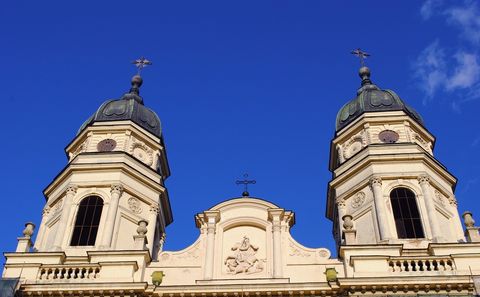 Bishop Veniamin Costache is the one who had the idea of building in Iasi a monumental church. The plan for this church was designed by the architects Johann Freywald and Bucher. The works took place first between 1833-1839 and then between 1880-1887, this time following the plans of the Romanian architect, Alexandru Orascu. The painting of the cathedral was done by Gheorghe Tăttărescu.
Bishop Veniamin Costache is the one who had the idea of building in Iasi a monumental church. The plan for this church was designed by the architects Johann Freywald and Bucher. The works took place first between 1833-1839 and then between 1880-1887, this time following the plans of the Romanian architect, Alexandru Orascu. The painting of the cathedral was done by Gheorghe Tăttărescu.It was inaugurated on 23April 1887, at this event also taking part King Carol I and Bishop Iosif Naniescu.
In 1889 the relics of Saint Parascheva were brought from Three Hierarchs Church to the new cathedral.
Palace of Culture
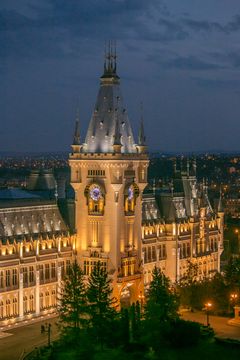 The Palace of Culture, acknowledged as the effigy of the city of Iasi, was built in Neogothic style and as such was one of the last expressions of Romanticism in the official architecture.
The Palace of Culture, acknowledged as the effigy of the city of Iasi, was built in Neogothic style and as such was one of the last expressions of Romanticism in the official architecture. Although it was not built on top of ancient foundations, as people thought at the beginning of the XX-th century, the Palace was partly built on top of ruins of the Medieval princely courts, mentioned in a document from 1434. The edifice was built between 1906 and 1925, and is the most outstanding work of Romanian architect I.D. Berindei, who was trained at the Parisian School.
In spite of its archaic-looking design, the Palace was designed to integrate modern materials and technologies. Thus, the stone blocks were replaced with lighter and much cheaper materials. Besides, some rooms were decorated using a special material licensed by Henri Coanda, under the name of bois-cement, oak wood. Decorative ironmongery elements are also remarkable and they can be admired for instance on the doors of Voivod Hall.
The building was also equipped with high-tech facilities during those times, such as electric lighting, (pneumatic) heating, a ventilation system, thermostat, vacuum cleaners, which were all directed from the machinery room, at the basement level.
The building, inaugurated on October 11, 1925, served as the Palace of Justice until 1955, when its destination was changed, being assigned to the museums nowadays united under the name of Moldova National Museum Complex of Iasi,
Anastasie Fătu Botanical Garden
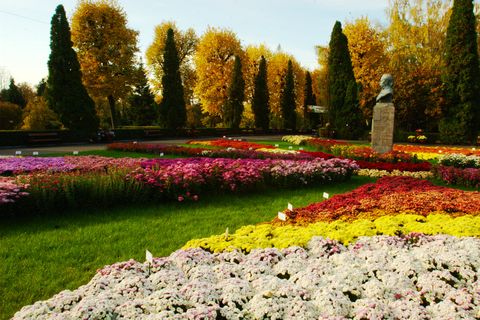 The Botanical Garden, founded in 1856, is named after its founder, the physician and naturalist Anastasie Fătu. It is the first Romanian university botanical garden and at the same time the largest in the country, unique through the high number of plant species and the special conservation measures. The establishment of the botanical garden on the Copou Hill, started in 1963 was continued and permanently improved. On the present emplacement it has a surface of 88.55 ha being organized in 10 sections: Systematic, World Fora, Greenhouse Complex, Romanian Flora and Vegetation, Moldavian Silvosteppe, Biologic, Useful Plants, Dendrarium, Ornamental and Rosary.
The Botanical Garden, founded in 1856, is named after its founder, the physician and naturalist Anastasie Fătu. It is the first Romanian university botanical garden and at the same time the largest in the country, unique through the high number of plant species and the special conservation measures. The establishment of the botanical garden on the Copou Hill, started in 1963 was continued and permanently improved. On the present emplacement it has a surface of 88.55 ha being organized in 10 sections: Systematic, World Fora, Greenhouse Complex, Romanian Flora and Vegetation, Moldavian Silvosteppe, Biologic, Useful Plants, Dendrarium, Ornamental and Rosary.Today the collections of the Botanical Garden gather 8,368 taxa from different biogeographical regions that are cultivated outside or in protected conditions. The natural settings offer excellent conditions for the preservation of indigenous and exotic plants genetic found, education, research and recreation.
The unique character of the Botanical Garden from Iași is given by the remarkable patrimonial value of the scientific collections and the special section dedicated to sightless people, where plant species rich in volatiles are presented together with descriptions in Braille alphabet.
Copou Park
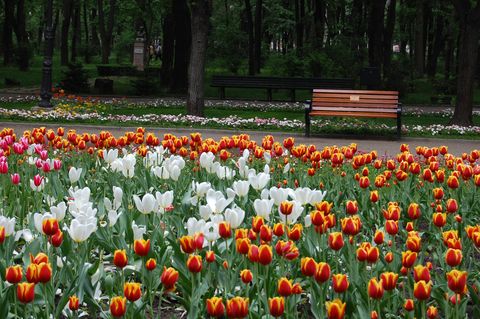
On 'Junimea" alley, bronze busts of the members of this well-known cultural organization in Iasi can be admired.
Moldova State Philharmonic
This building, which initially belonged to the treasurer Alecu Bals, was built around 1815, in neoclassic style, typical for the end of the 18th century and the beginning of the 19th century. Later, the building hosted the Sacré Coeur French Institute for nuns of the Notre Dame de Sion Congregation.
Take a tour of the famous Northern Moldavian monasteries. Many of them are painted, dating back to the 15th – 16th centuries and are included in the UNESCO patrimony.
• the Monastery of Voroneţ is very well known due to its unique shades of blue and to the mural representing the "Last Judgement” on its western exterior wall;

• the Monastery of Putna has a powerful symbolical meaning for the Romanian people because it was built by the most famous Moldavian ruler, Ștefan cel Mare (Stephen the Great), who is also buried there;
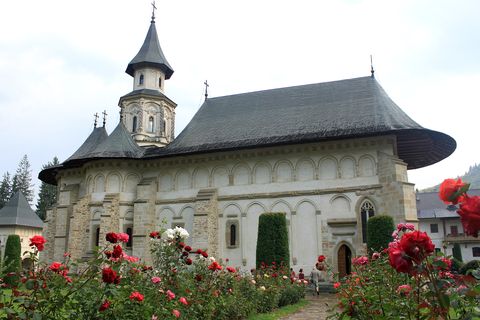
• the Monasteries of Suceviţa, Moldoviţa, Dragomirna, Arbore, Bistrita, Agapia, Văratec and many others are all beautifully-painted monuments of of great artistic and religious value.

